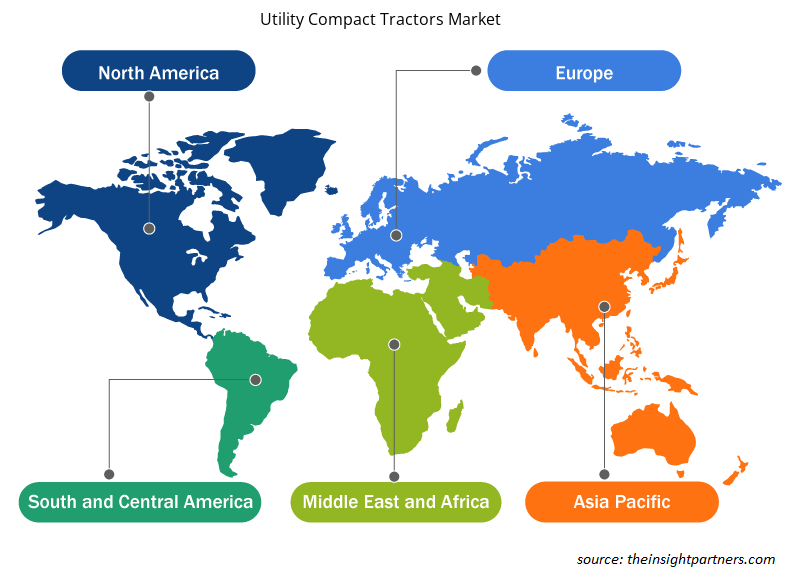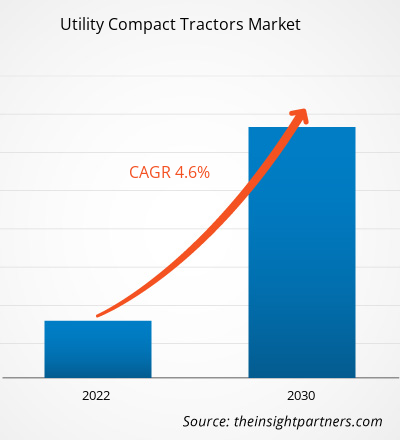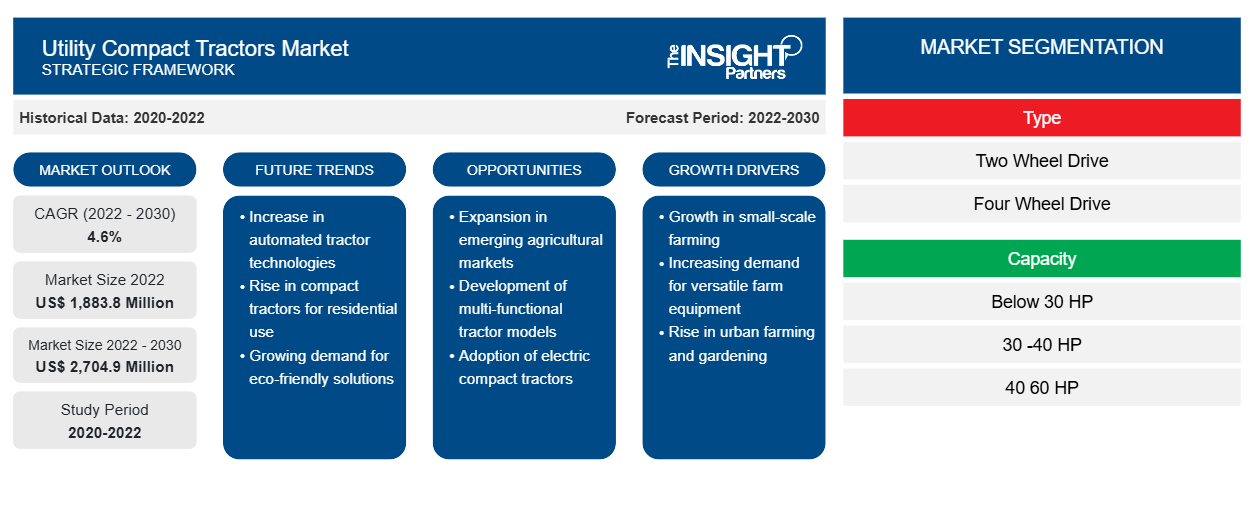[調査レポート] ユーティリティ小型トラクターの市場規模は、2022年の18億8,380万米ドルから2030年には27億490万米ドルに急増すると予測されており、2022年から2030年にかけて4.6%のCAGRを記録すると予想されています。
アナリストの視点:
建設、造園、動物管理、芝生管理における小型トラクターの使用増加は、ユーティリティ小型トラクター市場の成長に貢献する重要な要因です。これらのトラクターは、持ち上げ、草刈り、牽引、運搬、土壌管理活動に利用されています。造園プロジェクトへの投資の増加と建設業界の急増は、ユーティリティ小型トラクターの採用を直接促進しています。オックスフォードエコノミクスが2023年に発表したデータによると、建設工事の価値は、中国、米国、インドなどの巨大市場が主導し、2022年の9.7兆米ドルから2037年までに13.9兆米ドルに増加すると予想されています。インドは最も急速に成長している建設超大国の一つとして浮上しており、英国は西ヨーロッパで最も急速に拡大する建設市場になると予想されています。さらに、ドイツ、フランス、ロシア、ノルウェー、スイス、スペイン、スウェーデンなどの国では降雪が一般的な現象であり、小型ユーティリティトラクターは除雪作業で一般的に使用されています。 2023年12月、モスクワでは大雪が降り、交通が混乱しました。ロシア政府が提供するデータによると、除雪にはユーティリティコンパクトトラクターを含む約2万台の機械が使用されました。このように、除雪のニーズと、増加する造園および建設プロジェクトにより、ヨーロッパだけでなく世界の他の地域でユーティリティコンパクトトラクターの採用が促進されています。
市場概要:
小型トラクターは農業でよく使用されますが、建設、採鉱、造園、芝刈りなどの作業にも使用されています。これらのトラクターは、フルサイズのトラクターに比べて経済的でメンテナンスも簡単です。さらに、小型トラクターは、そのデザインとコンパクトでありながら強力なエンジンにより、狭いスペースでも簡単に管理できます。小型ユーティリティトラクターには、従来の燃焼エンジンや完全電動モーターなど、さまざまな駆動タイプがあります。
アジア太平洋地域は、主に建設および鉱業の継続的な成長により、世界および国内の小型ユーティリティトラクターベンダーに有利な機会を生み出すと予測されています。オックスフォードエコノミクスが2023年に発表したデータによると、アジア太平洋地域は2030年までに世界の建設セクターに7.4兆米ドルを生み出すと予想されています。さらに、この地域の継続的な産業成長により、鉱業活動は今後数年間で急速に拡大すると予測されています。したがって、産業部門の継続的な成長は、最終的にユーティリティコンパクトトラクター市場の成長をサポートします。北米とヨーロッパは、今後数年間で世界市場で高い成長率を記録すると予想されています。カナダ、ドイツ、オーストリア、ロシア、スウェーデンなどは、降雪率が最も高くなっています。さらに、米国の他の国と比較して、造園と芝生管理の需要が高いです。したがって、これらの国では、除雪や造園活動のためのユーティリティコンパクトトラクターの採用が高くなっています。
要件に合わせてレポートをカスタマイズする
このレポートの一部、国レベルの分析、Excelデータパックなど、あらゆるレポートを無料でカスタマイズできます。また、スタートアップや大学向けのお得なオファーや割引もご利用いただけます。
- このレポートの主要な市場動向を入手してください。この無料サンプルには、市場動向から見積もりや予測に至るまでのデータ分析が含まれます。
市場の推進要因:
造園・芝生管理サービスの需要増加
芝生管理サービスは通常、芝生と土壌管理に関連する幅広い活動とその維持管理をカバーしています。これらには、芝刈り、縁取り、剪定、施肥、雑草駆除、害虫管理、散水が含まれます。一部の芝生管理ビジネスでは、エアレーション、オーバーシーディング、芝の設置などの追加サービスを提供する場合があります。 2022年のInsight Partnersの分析によると、造園および芝生管理サービスは2022年に約2,000億米ドルに達しました。米国は、造園および芝生管理サービスの主要市場の1つです。米国の消費者は、プロの造園および芝生管理サービスに約300億米ドルを費やしています。さらに、景観改善への政府支出は、造園業界、そして最終的にはユーティリティコンパクトトラクター市場に利益をもたらすもう1つの要因です。たとえば、2023年12月、米国政府は景観修復活動に1億6,100万米ドルを発表しました。この資金の助けを借りて、政府は21の景観の修復を完了する予定です。このようなサービスへの支出の増加は、ユーティリティコンパクトトラクターなどの造園機器の需要を促進します。したがって、造園および芝生管理サービスの需要の増加は、ユーティリティコンパクトトラクター市場規模の拡大に大きく貢献します。
セグメント分析:
ユーティリティコンパクトトラクター市場の分析は、タイプ、容量、ドライブタイプのセグメントを考慮して実施されました。容量に基づいて、市場は30HP未満、30〜40HP、40〜60HPに分割されています。40〜60HPセグメントは、2022年にユーティリティコンパクトトラクター市場シェアの60%以上を占めました。
40~60馬力のカテゴリーのユーティリティコンパクトトラクターは、造園や芝生の手入れサービスプロバイダーによって、耕作、荷役、運搬などの作業に広く使用されています。小型トラクターメーカーによる製品開発活動は、市場の進歩をさらに推進します。たとえば、2023年2月、クボタは40馬力のLX4020小型トラクターを発売しました。このモデルは、より幅広の車軸を特徴としており、全体的な操縦性が向上し、造園や芝生の手入れ作業への適合性を高めています。
地域分析:
ユーティリティコンパクトトラクター市場レポートの地理的範囲には、北米(米国、カナダ、メキシコ)、ヨーロッパ(スペイン、英国、ドイツ、フランス、イタリア、その他のヨーロッパ)、アジア太平洋(韓国、中国、インド、日本、オーストラリア、その他のアジア太平洋)、中東およびアフリカ(南アフリカ、サウジアラビア、UAE、その他の中東およびアフリカ)、南米および中米(ブラジル、アルゼンチン、その他の南米および中米)が含まれます。北米のユーティリティコンパクトトラクター市場は、米国、カナダ、メキシコに分割されています。米国、カナダ、メキシコなどの国の造園および芝生管理メンテナンス業界は、ユーティリティコンパクトトラクターの需要を主に牽引しています。
北米は、造園および建設業界の着実な成長により、今後数年間、ユーティリティコンパクトトラクターの市場シェアを引き続き支配すると予想されます。建設業界は米国経済に大きく貢献しています。2023年第1四半期の国内の建設事業所は約919,000社で、毎年約2.1兆米ドル相当の建築プロジェクトを完了しています。カナダでは、建設部門は2022年にGDPへの6番目に大きな貢献者でした。カナダの建設業界は、2022年に約2,500億米ドルの年間収益を生み出しました。この業界からの需要に加えて、カナダの各州で受けた大雪は、ユーティリティコンパクトトラクターの採用を促進する注目すべき要因です。米国では、炭素排出の好みの高まりと電気自動車の採用の増加により、来年はユーティリティコンパクトトラクター市場の新しいトレンドがもたらされると予想されます。
ユーティリティコンパクトトラクター市場地域別分析
予測期間を通じてユーティリティ コンパクト トラクター市場に影響を与える地域的な傾向と要因は、Insight Partners のアナリストによって徹底的に説明されています。このセクションでは、ユーティリティ コンパクト トラクター市場のセグメントと、北米、ヨーロッパ、アジア太平洋、中東、アフリカ、南米、中米の地域についても説明します。

- ユーティリティコンパクトトラクター市場の地域別データを入手
ユーティリティコンパクトトラクター市場レポートの範囲
| レポート属性 | 詳細 |
|---|---|
| 2022年の市場規模 | 18億8,380万米ドル |
| 2030年までの市場規模 | 27億490万米ドル |
| 世界のCAGR(2022年 - 2030年) | 4.6% |
| 履歴データ | 2020-2022 |
| 予測期間 | 2022-2030 |
| 対象セグメント | タイプ別
|
| 対象地域と国 | 北米
|
| 市場リーダーと主要企業プロフィール |
|
ユーティリティコンパクトトラクター市場のプレーヤー密度:ビジネスダイナミクスへの影響を理解する
ユーティリティ コンパクト トラクター市場は、消費者の嗜好の変化、技術の進歩、製品の利点に対する認識の高まりなどの要因により、エンド ユーザーの需要が高まり、急速に成長しています。需要が高まるにつれて、企業は提供内容を拡大し、消費者のニーズを満たすために革新し、新たなトレンドを活用し、市場の成長をさらに促進しています。
市場プレーヤー密度とは、特定の市場または業界内で活動している企業または会社の分布を指します。これは、特定の市場スペースに、その規模または総市場価値と比較して、どれだけの競合相手 (市場プレーヤー) が存在するかを示します。
ユーティリティコンパクトトラクター市場で事業を展開している主要企業は次のとおりです。
- ヤンマートラクター
- マヒンドラ
- TYM株式会社
- ソレクトラック
- ジョンディア
免責事項:上記の企業は、特定の順序でランク付けされていません。

- ユーティリティコンパクトトラクター市場のトップキープレーヤーの概要を入手
主要プレーヤー分析:
Bobcat Company、Mahindra Tractors、Kubota、John Deere、Massey Ferguson、TYM、Yanmar、New Holland は、ユーティリティ小型トラクター市場レポートで紹介されている主要企業の一部です。さらに、市場の全体的な概要を把握するために、この市場調査研究中に他のいくつかの重要な企業も調査および分析されました。
最近の動向:
合併や買収などの無機的および有機的な戦略は、ユーティリティ小型トラクター市場の企業によって広く採用されています。主要な市場プレーヤーによる最近の動向をいくつか以下に示します。
年 | ニュース | 地域 |
2023年3月 | TYM は、テレマティクス システム (T76 のみ) と油圧トップ リンクを備えた 4 台のトラクターの新シリーズを発売しました。 | アジア太平洋 |
2023年5月 | ジョンディアは、3R シリーズおよび 4 シリーズの小型ユーティリティ トラクターに 2024 年モデルの強化機能を導入しました。これらのトラクターには、商業用除雪に役立つアクセサリが装備されています。 | 北米 |
- 過去2年間の分析、基準年、CAGRによる予測(7年間)
- PEST分析とSWOT分析
- 市場規模価値/数量 - 世界、地域、国
- 業界と競争環境
- Excel データセット
最新レポート
お客様の声
購入理由
- 情報に基づいた意思決定
- 市場動向の理解
- 競合分析
- 顧客インサイト
- 市場予測
- リスク軽減
- 戦略計画
- 投資の正当性
- 新興市場の特定
- マーケティング戦略の強化
- 業務効率の向上
- 規制動向への対応





















 無料サンプルを入手 - ユーティリティコンパクトトラクター市場
無料サンプルを入手 - ユーティリティコンパクトトラクター市場